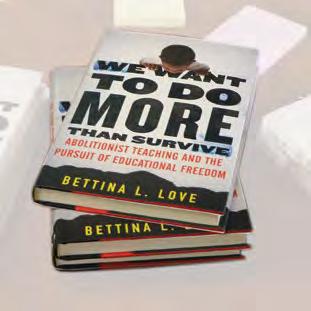
18 minute read
Feature: A Dynamic Transformation: Reimagining Our Purpose and Place
Dallas ISD teachers now lead gallery walks in which students post their thoughts on large sheets of paper hung on the wall and then walk the room to read different viewpoints. Teachers also place students into pair or trio discussions in which students have small group discussions guided by a teacher’s prompt.
Quick writes are another innovative instructional tool introduced by the Pitt researchers. Students are told to quickly write down their thoughts in response to a writing prompt. The writing is meant to be a predecessor to a formal outline or first draft. The act helps students to organize their thoughts, which prepares them for when it is time to write the longer assignment.
To show their students how this works, some teachers have put themselves on the spot. One teacher did her own quick write on a subject unfamiliar to her but well known to her students: the lyrics of a song by the Atlanta rapper Lil Baby. The teacher struggled mightily. The students shared a laugh at her expense. But that was okay. The students got the message.
“Modeling vulnerability for children is one of the most important things you can do for a child. It shows that making mistakes isn’t just tolerated, it’s a vital part of the process,” says Darlene Seeley, a ninth-grade English teacher at W.T. White High School.
Preparing Students for Life
There are still several years to go in the project, but early results are promising, according to school officials.
Tracie Washington, executive director of the Dallas ISD, recalls a recent visit to an eighth-grade classroom. The teacher was leading a discussion on the poem “We Wear the Mask” by Paul Laurence Dunbar. At that moment, a Black male who was an athlete—a person who appeared to be very reserved in the back of the room— voluntarily spoke up. He identified the poem as an extended metaphor, which caused the class to erupt into a spirited debate.
“It was like watching a volleyball going back and forth, watching the conversation around the room. It is the epitome of what I want to see happen in the students’ discussion of the text,” says Washington.
Another observation that is important to senior administration at the Dallas ISD is that schools are starting to demonstrate quantifiable gains in writing. “It’s starting to stick. We’re seeing double-digit gains in every area in the common assessment this year versus last year,” says Washington.
Principals are noticing positive changes in their schools as well.
“The process is not only helping our students to become more proficient writers, it helps the teachers to hone their craft. Both are growing together,” says Jonathan Smith, principal of David W. Carter High School.
Diana Nuñez, principal of W.H. Adamson High School, has been an educator in the Dallas ISD for nearly 20 years. She has been amazed by how involved the students have become in their writing assignments, which she says “is not always the case.” She attributes the success to the buy-in by the teachers and the cultural relevance of the texts.
“Our main goal is to prepare kids for life, not just the test. The more rigor that we infuse, that increases our chance of meeting it,” said Nuñez.
Ivonne Durant, chief academic officer of Dallas ISD, says there is interest in expanding the project’s reach and increasing teachers’ professional development opportunities. She has heard from administrators in the pilot schools who want to expand it to additional grade levels and from administrators outside the project who want to have their schools join the pilot.
“It’s never easy to work with a district as large and diverse as ours. We have the highest poverty levels in the state of Texas. Our English learners population exceeds the state average. I’ve seen the work that our children are now producing, though.
Measuring the Health of Networks
The initiative in the Dallas ISD is an example of a network for school improvement. Beyond this project, School of Education faculty member Jennifer Russell has received a $1.5 million grant from the Bill & Melinda Gates Foundation to assess the health of other networks for school improvement that are occurring nationwide. “The project seeks to answer how network leaders and the Gates Foundation can support the development and health of these networks,” says Russell.
It exceeds my wildest dreams,” says Durant.
Positive results also are occurring at the Thomas C. Marsh Preparatory Academy, where teachers and students have embraced the changes that are requiring higher-order cognitive thinking, says Brittany Thompson, an assistant principal who oversees the English language arts department. It is her habit to refer to students in the school as “scholars.” She explains that this is because they are increasingly taking ownership of their learning journey.
“This work has made our scholars feel more accountable. We’re not spoonfeeding it to them anymore. They are doing the work,” says Thompson.
Araujo, the eighth grader at Marsh, is among the students who enjoy the added instructional rigor. As he prepares to enter high school, he says his favorite book is the Holocaust memoir “Night” by Elie Wiesel. The book opened his eyes to worldviews outside the United States.
“In college, I know that everyone has to write a lot of essays. We are practicing a lot for that now,” says Araujo.
His classroom experience is now more enjoyable. It also is preparing him for a brighter future. ◆
A DynamicTransformation: Reimagining Our Purpose and Place
Guided by its new mission-vision, which is grounded in equity, justice, engagement, and innovation, the School of Education has embarked on a journey of progress and change. The school adopted new academic structures, invested in new technologies, created new leadership positions, and hired new faculty. The results are energizing the school community and sparking new outlets for teaching and learning.
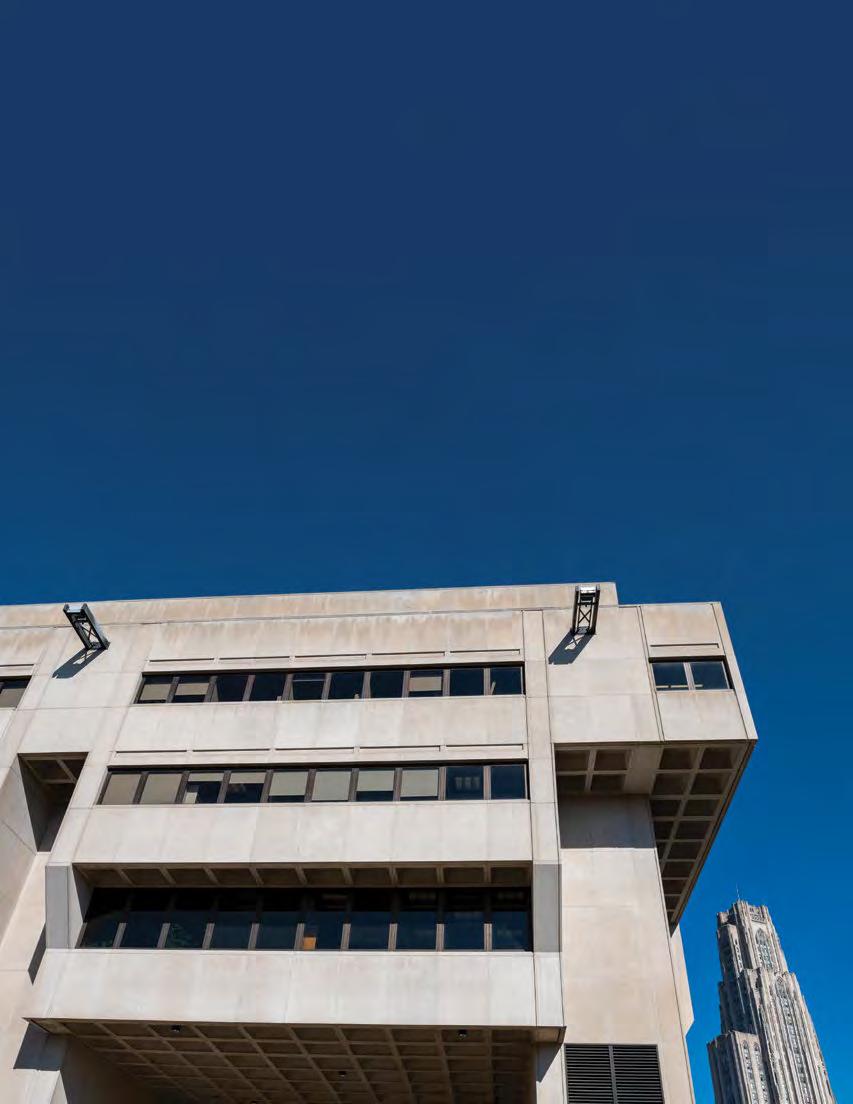
W ritten by Laura Roop Photographs by Pitt Visual Services a nd CourtneyRoss (as noted)
Unprecedented challenges call for dynamic responses. When the leaders of the University of Pittsburgh School of Education navigated wave after wave of changing conditions during the COVID-19 pandemic this past spring term, they let the values expressed in the school’s new mission-vision statement guide their words and actions.
For instance, on the first day that the spring semester resumed in a new online learning format following an extended break, Valerie Kinloch, the Renée and
Richard Goldman Dean, sent a schoolwide communication to students, staff, and faculty. In her message, she balanced the need to share time-sensitive resources, information, and next steps with words of inspiration to unite the school community. She encouraged students, staff, and faculty to transform this time of crisis into an opportunity to help others and embrace the school’s new cultural drivers and strategic priorities.
As Kinloch shared: “I ask that we remain mindful of the reality we are all experiencing, which includes increased stress, anxiety, and uncertainty; economic hardship for many as a result of
Pennsylvania’s new work restrictions; and serious health concerns for many people, including those we might know and love.
This makes it all the more important for us to show each other grace and kindness, to embody dignity and integrity, and to recommit to our school’s mission-vision.”
The mission-vision she referenced has become the guiding force of the dynamic transformation occurring in the
School of Education. The school recently embarked on a collective journey aimed at supporting the health and well-being of all learners in any environment where learning occurs. Guiding this journey are the twin pillars of educational equity and justice, which spark continual innovation, engagement, and community support. To advance this new work, the school undertook a comprehensive reorganization of its academic and operational units, created new leadership positions, hired new faculty, invested in innovative technologies, and is pursuing forward-thinking academic programs and research-practice partnerships.
“This transformation that our School of Education is undergoing—this is for all of us,” says Kinloch, who became dean of the school on July 1, 2017.
COURTNEY ROSS Renovation of the School of Education offices and student spaces in Wesley W. Posvar Hall

Building a Foundation for the Future
The provocative phrase “We ignite learning” opens the mission-vision statement for the School of Education. The entire 115-word statement provides a direction for how the school should navigate the uncertain terrain of the COVID-19 pandemic as well as offers a road map for larger strategic decisions that need to be made.
The mission-vision is a collective work. It began with a murmur of voices— pairs, small groups, and larger topical discussions—over the first year and a half of Kinloch’s deanship. The voices included those of faculty, staff, students, generations of alumni, community partners, and colleagues from across campus and the country. After former Dean Alan Lesgold retired following 16 years of administrative service, paired with more than 45 years of professorial work, faculty and staff in the School began asking new questions. What do we believe? What actions and programs make a difference? What are our strengths? What could be improved? What do we dream of doing? What does the region and nation need from us? What might be keeping us from fully realizing and operationalizing our potential?
After receiving insights and perspectives from various people connected to the School of Education over
School of Education Mission-Vision
We ignite learning. We strive for well-being for all. We teach. We commit to student, family, and community success. We commit to educational equity. We advocate. We work for justice. We cultivate relationships. We forge engaged partnerships. We collaborate. We learn with and from communities. We innovate and agitate. We pursue and produce knowledge. We research. We disrupt and transform inequitable educational structures. We approach learning as intertwined with health, wellness, and human development. We address how national, global, social, and technological change impacts learning. We shape practice and policy. We teach with and for dignity. We think. We dream. We lead with integrity. We are the School of Education at the University of Pittsburgh.
a 16-month period, Kinloch woke up early one morning and drafted a version of the new mission-vision statement. She shared it with the school community, asking for feedback and suggestions.
“For me, the mission-vision statement is a battle cry and call to action that resonates with my own personal mission of cultivating community uplift and
generational change, especially for people who look like me,” said Daren Ellerbee, director of Pitt’s Community Engagement Center in Homewood.
“I’m proud to be one of many lifting this banner,” says Ellerbee, who also is a student in the school’s Doctor of Education program.
Leaders at other schools of education around the country have called the School of Education’s new missionvision statement provocative, poetic and even courageous. Within the school, it is helping to shape big changes in structure, organization, hiring, and even the physical locations where the school does its work. Most importantly, it is energizing the ethos with which the school’s core work is conducted.
Adopting Powerful New Organizing Structures
To support the new missionvision, the School of Education recently enacted a comprehensive reorganization of its academic units and administrative departments. The changes were authorized by University of Pittsburgh Chancellor Patrick Gallagher on January 1, 2020, and represent the most sweeping changes to the structure of the school in 30 years.
The school shifted from six academic units to three new academic departments: Educational Foundations, Organizations, and Policy; Health and Human Development; and Teaching, Learning, and Leading. To support the work of the academic departments, the school also created three divisions for cross-departmental training and conversations. The divisions are Research Training, Innovative Leadership, and Undergraduate and Professional Training.
The intention of these structural changes is to open up new possibilities for breaking down silos in order to collaborate across disciplinary boundaries. In addition, the streamlined design enhances student experiences, positions centers and institutes as collaborative sites, and increases efficiencies across the school.
The new chair of Health and Human Development, Tom Farmer, says that this newly formed department merges the strengths of two former departments— Health and Physical Activity and Psychology in Education—which were
Reorganization Overview
The School of Education has completed a comprehensive reorganization of its academic and administrative units. The school moved from six academic units to three academic departments, created new training divisions, and engaged in a st aff restructuring.
Old Structure: Academic Units
DEPARTMENT OF INSTRUCTION AND LEARNING DEPARTMENT OF ADMINISTRATIVE AND POLICY STUDIES New Structure: Academic Departments
* The Center for Urban
Education continues to exist at the school as a preeminent center for research and community engagement. TEACHING, LEARNING, AND LEADING
DEPARTMENT OF PSYCHOLOGY IN EDUCATION
DEPARTMENT OF HEALTH AND PHYSICAL ACTIVITY
CENTER FOR URBAN EDUCATION *
LEARNING SCIENCES AND POLICY
TRAINING DIVISIONS RESEARCH TRAINING, INNOVATIVE LEADERSHIP, AND UNDERGRADUATE AND PROFESSIONAL TRAINING HEALTH AND HUMAN DEVELOPMENT
EDUCATIONAL FOUNDATIONS, ORGANIZATIONS, AND POLICY

previously organized separately. “This new department will allow us to conduct cutting-edge work that focuses on the whole individual in context and spans the life course from infancy to the twilight years and across generations,” says Farmer.
“Our new department will develop an infrastructure that fosters synergies and identifies ways that we differ,” he says. “This approach will allow us to develop new strengths, possibilities, and innovations that we could not achieve separately.”
Similar care was taken to identify logical ties and possible collaborative work within the other new departments and divisions.
Tackling the “Wicked Problems” in Education
According to Kevin Crowley, associate dean for faculty and research, the School of Education is moving in a direction that will allow it to address the big, almost-impossible-tosolve problems in education. The social sciences call them “wicked problems.”
“We have big aspirations. We’re building on the school’s past, but we need new structures for this century. If we’re focusing on equity and justice, disruption, and innovation, we need to think about ourselves differently as a school of education,” says Crowley.
Crowley heads the new Research Training division. “We’re aiming to become a stronger multidisciplinary scholarly community,” he said. “We want to organize and train, so we are sharing power between the University and the learning ecosystems with which we engage.”
Associate Dean for Academic Programs Lindsay Clare Matsumura has been leading efforts to grow degree and non-degree programs. The school has recently added new programs in urban education and health management while also experimenting with new formats, including stackable credentials through an online program in STEAM Education (Science, Technology, Engineering, Art, and Mathematics).
Matsumura asks, “What is the role of universities in our society? How can we be part of people’s learning needs over their life spans?” She is especially interested in figuring out how the school
Leigh Patel
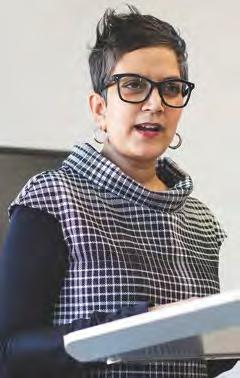
can connect in communities that are not place-based. “By carefully integrating online learning into our programs, we can become much more responsive to the needs of adult learners,” she said.
She is encouraged that the school is beginning to build on its networks with research-practice partnerships that generate equitable learning opportunities. Partners—including alumni, current students, districts, communities, staff, and faculty—are creating new knowledge that is shared broadly. People can stay in community using both face-to-face and online means. Matsumura envisions a network of changemaking communities, learning together across the boundaries of place and time.
Tinukwa Boulder

New Positions Lead to Exciting Action
To support the school’s missionvision, two new leadership positions were recently created: associate dean for equity and justice, and director of innovative technologies and online learning.
The School of Education’s first Associate Dean for Equity and Justice Leigh Patel explains that her role is to help the school, collectively, look carefully at the range of practices, from admissions to hiring to working conditions, that are necessary to foster a more equitable community of learning.
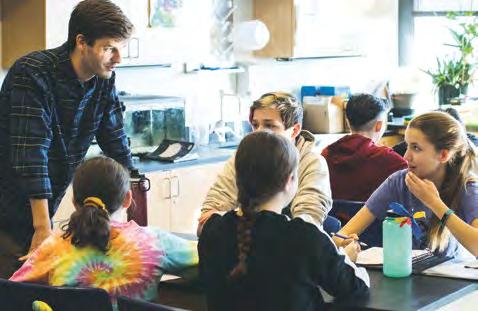
“My goal is to help the school as a whole understand, at every single juncture, that we are creating obstacles and opportunities, likely at the same time,” says Patel. Rather than focusing on “how many of this or that,” she says, “equity asks different questions. Who has access to what? Who is suffering, and who is well? Who wants to get into the room and can’t?” Patel concludes, “We will be able to do a lot as a School of Education, when people come from a place of wellness within.”
Tinukwa Boulder joined the school this past February as an associate professor and director of innovative technologies and online learning. While the school has designed online courses and learning opportunities for years, the entire University of Pittsburgh is moving from one learning management platform, Blackboard, to another, Canvas, this summer. The change in platforms can open new opportunities for collaboration and learning, she says.
“People need training and support if technology is really going to support teaching and learning,” says Boulder.
During the initial outbreak of the COVID-19 pandemic, Boulder stepped up to support faculty in the rapid transition to remote learning. She immediately created professional learning opportunities for faculty as they moved face-to-face courses to online learning platforms. In the longer term, Boulder believes that if the school can create a “culture of empowerment,” where faculty can try out new tools and share with one another, then exciting possibilities will emerge. Boulder and Patel are already teaming up to work on accessibility issues within online spaces.
New Ideas Call for Reimagined Spaces
As the School of Education has engaged in rethinking its vision, its structures, and its roles, an extensive renovation was completed on the fifth floor of Wesley W. Posvar Hall. The updated space features wellequipped conference and meeting rooms, remodeled offices with striking views of Oakland, and new student-friendly areas that are conducive to conversation and collaboration. There also is a Dean’s Colloquium Room, which serves as a large meeting room for school events and gatherings.

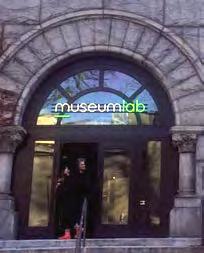
“This successful renovation represents an important change to the physical space of our school and also reflects key aspects of our strategic plan and new missionvision, most notably our commitment to innovation, engagement, and change,” says Rochelle Woods, senior assistant dean of administration, operations, and academic programs, who was responsible for overseeing the renovation. “The new space is designed to promote increased collaboration, productivity, creativity, and a more pleasant work environment.”
In addition to its renovations, the school has carved out new physical spaces in the community. Through space it has in the new Pitt Community Engagement Center in Homewood, the school has actively supported educational programs that engage with city residents. For example, students in the school’s Combined Accelerated Studies in Education program have volunteered in PittEnrich, which offers tutoring for elementary students at the center. The Healthy Lifestyle Institute also has hosted healthy eating and physical activity sessions for families. The Office of Child Development is leveraging the new space for emotional wellness programs, and additional school-based projects are unfolding nearby at Westinghouse Academy.
In addition, the school has secured new learning space in the MuseumLab on the North Side. This will support the school’s emerging research-practice partnership work in that area of the city, especially within the areas of out-ofschool learning and teacher education.
School leaders say that the decision to have space in historically disenfranchised communities within Pittsburgh is a signal of things to come.
Kinloch envisions a future where School of Education faculty, staff, students, and community members and agencies are participating in education hubs across the region, state, and globe. In these hubs, they would be able to collaborate, learn, and partner together to address issues and concerns as they emerge. She pictures a school that has “moved beyond silos and territorialism,” that “is not afraid to ask hard questions, roll up shirtsleeves, and act.”
“We have an obligation to stand by and with those who really need us,” says Kinloch. “Lives of kids, young people, and families depend on us getting this work right.” ◆
What does justice in education look like and want?
The School of Education's Equity
and Justice Scholars Program
supports doctoral students who
are committed to transforming
education through equityand
justice–based change. We asked

PhD students in the program to
answeran importantquestion
aboutjustice in education.
Nikki Cristobal
PhD student, Social and Comparative Analysis in Education Hometown: Kaua’i, Hawaii
“Justice in education wants to be understood for what it is: an action that continually and critically asks ‘What am I doing and for whom?’ Justice is an action that shifts the relational dy namics within systems of power that are pervasive in our educational systems and that maintain inequities by placing borders around what education is (it’s not synonymous with academia), what intellect is (it’s not an individual characteristic), and what schooling is (it’s not a perquisite for competence). Justice in education wants educational leaders (those with power) to take actions that change the material realities of those who are deemed (un) educated, (un)intellectual, and (in) competent.”
Marial exia Zaragoza
PhD Student, Higher Education Management Hometown: Riverside, California
“Justice in education wants equitable opportunities and outcomes for those involved, which include teachers, students, and families. It also wants change to current systems that continue to oppress marginalized communities. When I think of what justice in education looks like, I think we have yet to fully reach it. Justice in education would look like dismantling White supremacy, racism, and inequalities across all educational systems.”
Jawanza Rand
PhD student, Social and Comparative Analysis in Education Hometown: Jackson, Mississippi
“Taking seriously the notion that ‘justice is what love looks like in public’ (Cornel West), I imagine justice in education looking like teachers, principals, and superintendents centering a love ethos in their professional praxis, from policies to curriculum to pedagogy. Public education is fundamentally a humanitarian profession, rooted in care and concern for the healthy development of humans and society. Thus, justice in education wants the resources to pursue and implement the most ethical, equitable, and sustainable ways to educate and cultivate a caring, conscientious, civically engaged, highly literate and cosmopolitanready populace—including economic parity for teacher salaries.”






